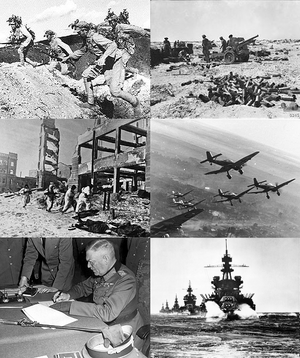Social War: Difference between revisions
old>Belfras No edit summary |
Ozycaevias (talk | contribs) m (1 revision imported: Ajax category without templates) |
(No difference)
| |
Revision as of 02:54, 11 January 2019
| Social War | |||||||
|---|---|---|---|---|---|---|---|
 Clockwise from top left: Social Republic forces in the Battle of Borea, Imperial 25-pounder guns during the First Battle of Kepetta, Social Republic Stuka dive bombers in December 1949, an Imperial naval vessel passing though the Mare Nostrum, Flavius Luonercus signing the Social Republic Instrument of Surrender | |||||||
| |||||||
| Belligerents | |||||||
|
|
| ||||||
| Commanders and leaders | |||||||
|
|
| ||||||
| Strength | |||||||
|
|
| ||||||
| Casualties and losses | |||||||
|
Military dead: some numbers Civilians dead: |
Military dead: some numbers Civilians dead: | ||||||
The Social War (Latin: Bellum Sociale), also called the 1945 War, was a civil war taking place in Latium from fall 1946 until early 1953 and was fought between the Latin Empire and the Latin Social Republic. The Imperials, led by Empress Diana, would defeat the Social Republic after nearly 3 years of fighting.
The war began in April 1945 with the 12 April coup perpetrated by Consul Orestes Cotta and members of the Voluntarius Militia National Obequio, the National Social Workers Movement Party's paramilitary branch. The coup saw the execution of many members of the Imperial Family and prominent members of court and government. The war essentially ended in January 1949 with the suicide of Cotta and the Imperial liberation of Alexandria, resulting in the fall of the Social Republic and the restoration of Imperial control to all of Latium.
Background
The 1934 general election saw the swift rise of the National Social Workers Movement, who capitalized on the political weariness of the Latin people during the economic decline and mismanagement of the previous year. Orestes Cotta of the National Social Workers Movement Party managed to become Consul following the 1937 snap elections. However, Cotta's consulship was extremely controversial after repeated attempts to enact laws to restrict the rights of ethnic and religious minorities, all of which were denied Imperial assent by Emperor Constantine XIX. Emperor Constantine eventually dissolved the Senate and called for new elections that saw the Liberals achieve a coaliton government.
The Liberal coalition government would last until 1944, though grew weaker and weaker over the course of 2 snap elections in 1941 due to the coercive actions of the NSWMP and their paramilitary group, the Voluntarius Militia National Obequio. Two more snap elections were called in 1944, seeing Cotta once again obtain the Consulship. Cotta continued to clash with Emperor Constantine XIX, though managed to enact laws that marginalized the opposition, including provisions to increase Senate membership from 725 to 1200 seats. By August 1946, Cotta and the NSWMP control nearly 80% of all seats in the Senate, with most non-party members even neglecting to attend sessions out of fear or disinterest.
Coup of 1945
Elevation of Diana Augusta
Initial movements
The start of the war saw the Social Republic centered on Alexandria, with control of nearly all Hellenic counties, and other counties to the east of the Frusina River, and originally claimed to maintain control of Castellum. Republican forces primarily use force or threat of force to coerce local governments east of the Frusina River to support the republican cause, often through brutal tactics. The Imperial support was largely focused on the counties west of the Frusina River, and saw wide-spread support from the nobility, including The Duke of Adrianople who raised the bulk of forces for the Imperial cause. The Duke of Adrianople moved quickly to secure the loyalties of the county governments located between Castellum and Adrianople. Adrianople reportedly marched his army of almost 1,000 to Castellum, where he accepted the surrender of the city. Empress Diana made her first public appearance and proclaimed Castellum her capital.